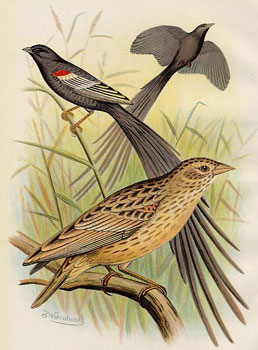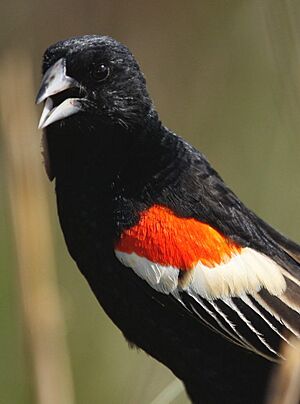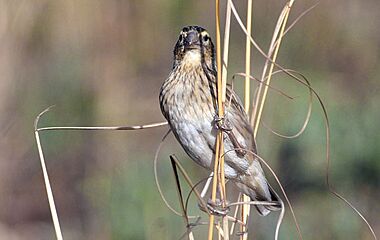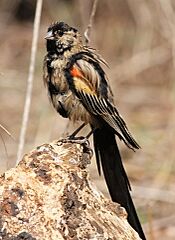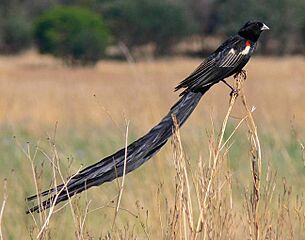Long-tailed widowbird facts for kids
Quick facts for kids Long-tailed widowbird |
|
|---|---|
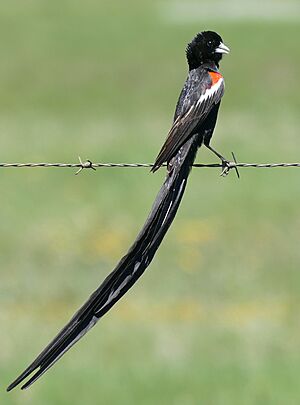 |
|
| A male Long-tailed widowbird on a fence in South Africa | |
| Conservation status | |
| Scientific classification | |
| Genus: |
Euplectes
|
| Species: |
progne
|
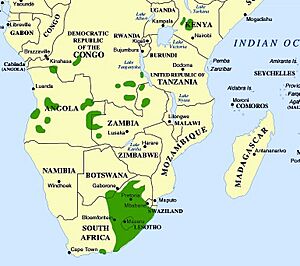 |
|
| Where they live | |
The long-tailed widowbird (Euplectes progne) is a cool bird from the Ploceidae family. You can find these birds in several African countries, like Angola, Botswana, Kenya, South Africa, and Zambia. They are a common sight in these areas.
Adult male long-tailed widowbirds are mostly black. They have bright orange and white patches on their shoulders, a long, wide tail, and a light blue bill. Females, however, are much less colorful. Their feathers are streaked with brown and black, and they have lighter patches on their chest and back. Their tails are narrow, and their bills are horn-colored.
When a male long-tailed widowbird flies, its super long tail makes it easy to spot! Six to eight of its twelve tail feathers can be about half a meter (20 inches) long. During flight displays, the male spreads its tail vertically. It flies slowly, about 0.5 to 2 meters (20 to 78 inches) above its territory.
Contents
About the Long-tailed Widowbird
What's in a Name?
The long-tailed widowbird was first described in 1779 by a French scientist named Georges-Louis Leclerc, Comte de Buffon. He saw a bird from the Cape of Good Hope in South Africa. Later, in 1783, a Dutch naturalist, Pieter Boddaert, gave it the scientific name Emberiza progne.
Today, this bird is part of the Euplectes group, which has 17 different species. The name Euplectes comes from Ancient Greek words meaning "fine" or "good" and "weaver." This refers to how well these birds build their nests. The word progne is Latin for "swallow."
Different Types of Long-tailed Widowbirds
There are three main types, or subspecies, of the long-tailed widowbird:
- E. p. delamerei: Found in central Kenya.
- E. p. delacouri: Found in Angola, southern DR Congo, and Zambia.
- E. p. progne: Found from southeast Botswana to eastern South Africa.
These different types live in separate areas. Some scientists think that long-tailed widowbirds might be part of a larger group of similar birds. This idea is based on how similar the males look during breeding season, especially their long tails.
Appearance of the Long-tailed Widowbird
How Males and Females Look Different
Long-tailed widowbirds show clear sexual dimorphism. This means males and females look very different.
Adult males are completely black, even under their wings. Their shoulder patches are bright orange-red and white. Their bills are bluish-white. Males are famous for their incredibly long tails. Six to eight of their twelve tail feathers can be about half a meter (20 inches) long! Their wingspan is about 127 to 147 mm (5 to 5.8 inches).
Females have much duller colors. The top part of a female's body is streaked with brown and black. Their chests and sides are a bit lighter. The area under their wings is black, and their tail feathers are thin and pointed. Their bills are horn-colored.
Young and Non-Breeding Birds
Males who are not breeding season are a bit bigger than females. However, they look very similar to females. They are streaked more broadly with brown and black. Their wings and shoulders look like those of breeding males. Sometimes, non-breeding males have slightly longer brownish-black tail feathers, but these are much shorter than those of breeding males.
Young male and female birds look a lot like adult females. But young males are slightly larger than adult females.
Female long-tailed widowbirds are about 15 cm (6 inches) long. Males can be up to 71 cm (28 inches) long, including their long tails! Males weigh between 33–46 grams, and females weigh between 25–39 grams.
Where Long-tailed Widowbirds Live
There are three separate groups of long-tailed widowbirds. One group lives in the highlands of Kenya. Another is in Angola, southern Zaire, and Zambia. The third group is in southern Africa. We don't know when these groups last met. The central group looks the most different from the other two.
The southern African group lives from the Eastern Cape (Transkei region) through the Free State, Lesotho, KwaZulu-Natal, and western Eswatini to the Transvaal plateau. They are most common in the central highveld of South Africa. They also just barely enter southeastern Botswana.
Long-tailed widowbirds usually live in swampy grasslands. They often gather in flocks with one or two males and several females. Males fly with their tails hanging down and spread out, moving their wings slowly. In wet weather, their long tails can make it hard for them to fly. When it's not breeding season, long-tailed widowbirds gather in large flocks. They often rest in tall reed beds. You can find these birds at high elevations, up to 2,750 meters (9,022 feet) in the Drakensberg Mountains.
Long-tailed Widowbird Behavior
What They Eat
Long-tailed widowbirds mainly eat seeds. Sometimes, they also eat small insects and spiders. They usually look for food in flocks on the ground. However, they sometimes catch insects in the air.
They eat seeds from many different plants. These include Setaria sphacelata (twisted-leaf bristle grass), Paspalum dilatatum (common paspalum), Paspalum distichum (couch paspalum), Pennisetum clandestinum (Kikuyu grass), Triticum (wheat), Themeda triandra (rooigras), and Senecio juniperinus (groundsel). They also enjoy eating beetles, cicadas, aphids, and spiders.
Reproduction and Nesting
Male long-tailed widowbirds protect their territories in the grasslands. Females spend a lot of time checking out these territories and the males in them before choosing a mate. Breeding season is from February to July, with the busiest time in March and April.
Females build large, dome-shaped nests in the tall grass within the male's territory. They line the nests with seedheads. The nests are placed about 0.5–1 meter (19 to 40 inches) off the ground in the upper part of tall grass (like Eleusine jaegeri). Females raise two to three young in these nests.
Females often mate with the male whose territory they nest in. After mating, females lay one to three eggs. These eggs are pale bluish-green with brown streaks. They are usually about 23.5 millimeters (0.9 inches) long and 16.5 mm (0.6 inches) wide.
The Male's Tail and Shoulder Patches
One reason females might like males with long tails is that the tail makes the male look much bigger. This makes him easier to see from far away in the open grassland. However, this probably isn't the only reason. Females spend a lot of time comparing males before choosing one, so they don't just rely on seeing them from a distance.
Scientists are still trying to figure out the exact purpose of the bright shoulder patches (called epaulets) on male long-tailed widowbirds. They are displayed during courtship and when males are showing off or threatening rivals. It seems that the long tail might be favored by females choosing a mate, while the bright shoulder patches might be used when males compete with each other.
Are They Endangered?
The long-tailed widowbird lives across a very large area. Because of this, it is not considered an endangered species. Its population is stable, meaning it's not decreasing quickly. While we don't have an exact number for the total population, scientists believe there are enough long-tailed widowbirds that they are not at risk. For these reasons, the species is listed as "least concern," meaning it's not currently threatened.
Images for kids



